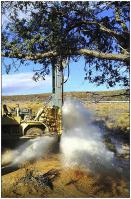Journal of African Earth Sciences ( IF 2.3 ) Pub Date : 2021-03-12 , DOI: 10.1016/j.jafrearsci.2021.104179 Johanna Margaretha van Rooyen , Sonia Veltman , Fanie Botha , Johan Matthee

|
Many South-African towns in the Western Cape Province are dependent on surface water sources to satisfy the ever-increasing water demand. In recent years, the effects of climate change on the environment has continually challenged these areas and recently led to calls for major changes in water management. The 2016–2018 extreme drought experienced throughout the greater Lower Olifants River Water Management Area, was anticipated in prior years due to projected climate change patterns, and recently, the need for groundwater resource development called upon.
The local economy of the Lower Olifants River is dependent on water releases from the Clanwilliam- and Bulshoek dams, located within the Olifants River Syncline (ORS), where ‘megafault’ zones form preferred flowpaths for groundwater in the Table Mountain Group (TMG) aquifers. The Lower Olifants River Water User Association (LORWUA) were mandated to proceed with the exploration and development of these aquifers to supplement the existing water use of the LORWUA. This will be available during periods of less rainfall and therefore increase the security to the water supplied.
The groundwater project aimed at exploring and developing the fractured rock aquifers of the Peninsula (Op) and Skurweberg (Ss) Formations contained within the TMG. Through geological knowledge, remote sensing investigations and geophysical ground surveys, several target areas and drilling priorities were identified in order to obtain high effective borehole yields, that access the resource in proximity to existing surface infrastructure. The project water demand to be developed from the groundwater resource was initially 4–5 Mm3/annum.
Faults/structure zones were the main hydrogeological targets, with higher yielding water strikes intersected below 100 m below ground level (m bgl).
Down-hole camera work and initial aquifer testing concluded that the specific geological contact zones and high yielding fractures are prone to sudden collapse with high yield pumping, which indicated the need for specific construction, prior to pump installations.
A major concern still to be resolved, is the availability of water in storage and the realistic expectations of the well-field over time. Although individual borehole testing provided information on specific water bearing structures’ properties, long term monitoring will provide a better understanding of the aquifer in response to pumping and recovery in times of rest.
The operating rules of the conjunctive use of the well-field developed, with the existing surface water scheme, is still to be defined and modelled for optimisation, pending long term monitoring.
中文翻译:

地下水资源勘探与开发–专注于地下水,以支持南非下奥利凡茨河的地表水供应
西开普省的许多南非城镇都依靠地表水来满足不断增长的用水需求。近年来,气候变化对环境的影响不断挑战这些地区,并导致对水管理进行重大变革的呼吁。在下奥利凡特河水管理区整个地区经历了2016-2018年的极端干旱,由于预计的气候变化模式以及最近对开发地下水资源的需求,预计在往年会出现。
下奥利凡特河的当地经济取决于奥利凡特河向斜线(ORS)内的克兰威廉和布尔舒克大坝的水释放,那里的“大型断层带”形成了桌山集团(TMG)含水层中地下水的优选流路。 。下奥利夫特河水使用者协会(LORWUA)受命继续进行这些含水层的勘探和开发,以补充该水源的现有用水。这将在降雨量较少的时期使用,因此可以提高所供应水的安全性。
地下水项目旨在探索和开发TMG内的半岛(Op)和Skurweberg(Ss)地层的裂隙含水层。通过地质知识,遥感勘测和地球物理地面勘测,确定了几个目标区域和钻探优先顺序,以获取高有效的井眼产量,从而在现有地表基础设施附近获取资源。从地下水开发的项目需水量最初为4-5 Mm 3 /年。
断层/构造带是主要的水文地质目标,在地面以下100 m以下(m bgl)相交的高产水罢工。
井下摄像机的工作和初始含水层测试得出的结论是,高产量泵送时,特定的地质接触区和高产裂缝易发生突然坍塌,这表明在安装泵之前需要进行特定的构造。
仍需解决的主要问题是存储中的水的可用性以及随着时间的推移对井场的现实期望。尽管单独的井眼测试提供了有关特定含水结构特性的信息,但是长期监测将更好地理解含水层,以响应休息时的抽水和恢复。
与现有的地表水方案一起开发的井场的联合使用的操作规则,仍需进行定义和建模,以进行优化,直至进行长期监测。


























 京公网安备 11010802027423号
京公网安备 11010802027423号